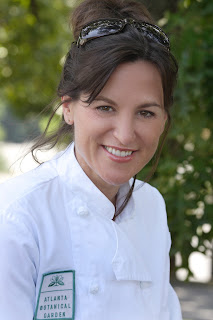I’m happy to introduce Plant to Plate’s guest blogger, Taylor Arnold, Conservation Intern at the
Atlanta Botanical Garden. Taylor is a graduate of the Savannah College of Art and Design with a B.A. in Illustration and an M.F.A. in Professional Writing. Since 2006 she has been a Contributing Writer for
The Piedmont Review where she writes a variety of articles on local art galleries, restaurants, boutiques and nightspots. Her work has also appeared in
Catalyst Magazine, as well as
Points North,
Jezebel,
Atlanta INtown,
Skirt! and
Atlanta Woman.
Just a few steps from the
Edible Garden, through the
Fuqua Orchid Center and into the Hardy Succulent Garden, you’ll find an edible plant with an interesting story – the agave. Taylor recounts a
Science Cafe presentation where the plant took center stage and attendees sipped on frozen margaritas - thanks to the agave.
Science Café Welcomes Dr. Kathy Parker to the Atlanta Botanical Garden
Thursday, July 21 was the third of six presentations in the 2011 series of
Science Cafes at the
Atlanta Botanical Garden, and we were delighted to have Dr. Kathy Parker as our featured speaker. Dr. Parker recently retired from the University of Georgia after 31 years in the Department of Geography. Her research covers plant population dynamics and genetics in the southwestern deserts, and she is particularly knowledgeable on the Arizona agave. Her discussion at the Garden covered the ancient domestication of agave in the pre-Columbian Southwest.
In keeping with the theme of the evening, the evolutionary
cocktail of the month was a frozen margarita. Guests who arrived early were invited to partake in a pre-Café discussion of the evolution of the margarita and learn about the botany, geography, and chemistry of its ingredients.
While most of us know that the agave plant is used to make tequila, it may come as a surprise that agave has many other purposes. So in conjunction with Dr. Parker’s discussion, we dug up a few more fun facts about agave:
• There are about 250 different species of agave in North and South America.
• Four major parts of the agave are edible: the flowers, leaves, stalks, and the sap.
• Agave azul, or blue agave, is used for the production of tequila.
• The agave Americana is called the “century plant” because it was thought to flower once in 100 years, but it actually flowers every 20 to 30 years.
• Agave syrup (also called agave nectar) is used as an alternative to sugar in cooking.
• The juice from the leaves of the flowering stem will lather in water like soap.
• Natives of Mexico used the agave to make pens, nails, and string.
• Indians used agave leaves to treat itches, sores, and bruises.
• The juice from many species of agave can cause reddening and blistering of the skin.
• Agave nectar has the same number of calories as sugar, four calories per gram. That works out to 16 calories per teaspoon.
• Many vegans prefer to use agave nectar in recipes calling for honey as no animals are involved in its processing.
• In 2001, the Mexican Government and European Union agreed upon the classification of tequila and its categories. All blue agave tequila must be made from the Weber blue agave plant, to rigorous specifications and only in certain Mexican states.
In addition to these stats, Dr. Parker explored the influences that native people had on the landscape of the Southwest. And she certainly knows what she’s talking about. For the last 35 years, Dr. Parker has spent time in Arizona and New Mexico researching the evolution of the agave plant. In 2002 she contributed to a book called
Western Wilderness: Fire, Native Peoples, and the Natural Landscape where she explored fire in the pre-European lowlands of the American southwest. “I’m fascinated by the adaptation of plants and animals to such a tough environment,” she said. “This is a great opportunity to share the story of the landscape and emphasizing the importance of maintaining biodiversity.”
As for her presentation at the Garden, Dr. Parker certainly appealed to a broad audience of science enthusiasts. “I hope to stimulate interest in the ways people have used native plant species in traditional agricultural systems,” she said. “Agave serves as a great example for several reasons. It is a plant that most people are familiar with. It played a crucial role for many different cultures in Mesoamerica and farther north both prehistorically and more recently. Agave cultivation also nicely illustrates both the importance of maintaining biodiversity and the role humans have played in shaping seemingly wild landscapes we see today.”
Dr. Parker gave her presentation in the
Fuqua Orchid Center, and following her discussion, we encouraged guests to stay for a guided tour of the conservatory with Paul Blackmore, manager of the
Garden’s Fuqua Conservatory.
Admission to the Garden is always free for members and $18.95 to non-members, and includes access to
Cocktails in the Garden.
Science Café is held every third Thursday from May to October.
For more information, visit
www.atlantabotanicalgarden.org/events.

































